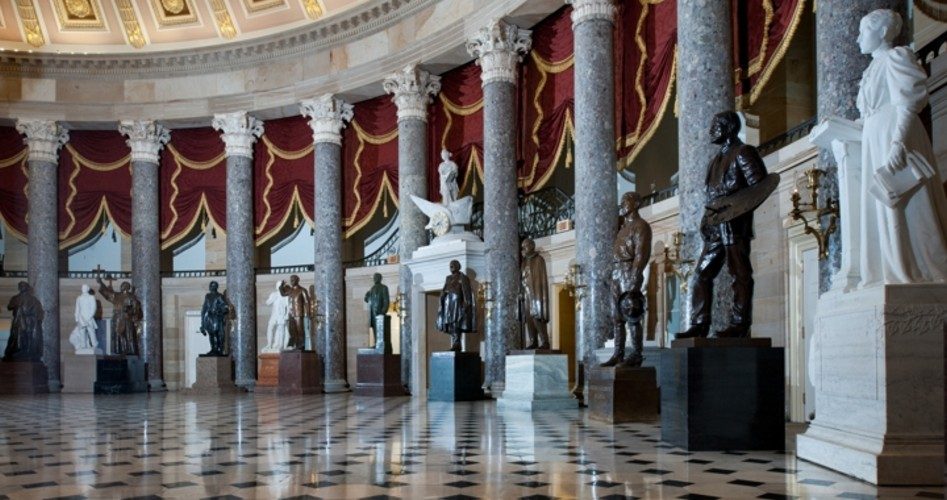
As the federal government faces yet another potential fiscal shutdown on September 30, House Democrats released spending bills on Monday that would put them clearly at odds with the Senate and President Trump. Among the unreasonable demands in the Democrats’ plan is a requirement that certain statues of Southern politicians and any Confederate statue remaining in the Capitol be removed and returned to the states that donated them.
Since passing budgets is, apparently, now a thing of the past in Washington, the federal government relies on a series of continuing resolutions (CR) — appropriations bills that set aside money for government agencies, departments, and programs. The current CR is scheduled to expire on September 30 when the U.S. government’s fiscal year ends.
With the general election on November 3, less than five weeks away from that deadline, Democrats are poised to create yet more disorder and confusion in a year that has already seen its share of chaos.
In a letter to the Joint Committee on the Library dated June 10, House Speaker Nancy Pelosi (D-Calif.) argued that the 11 statues in question are “plainly racist … and are a grotesque affront” to American ideals.
“While I believe that it is imperative that we never forget our history, lest we repeat it, I also believe there is no room for celebrating the violent bigotry of the men of the Confederacy in the hallowed halls of the United States Capitol or in places of honor across the country,” Pelosi wrote.
{modulepos inner_text_ad}
Pelosi may have a point (though whether she is sincere is another issue), but is this truly the hill the Democrats want to die on? Considering what’s already happened in 2020, a government shutdown only a little over a month from the general election doesn’t look good for anybody. And if the American public senses that the Speaker is ready to shut down the government over something as meaningless as statues that can’t do anything to anybody and will likely be replaced by the states over time, then she is completely misreading the 2020 electorate.
The statues in question are on display at the National Statuary Hall Collection at the Capitol (shown). Each state can contribute two statues to the collection and each state is allowed to replace those statues if the state’s legislature and governor approve of the change. Currently, there are 11 statues in the collection that the Democrats consider persona non grata — all of them contributed by Southern states. Their new appropriations bill would require the immediate removal of those statues.
But the states are the ones who donated the statues, and Senate Majority Leader Mitch McConnell argues that the fate of those monuments should be left up to those states. “Every state is allowed two statues. They can trade them out at any time,” McConnell said in June. “A number of states are trading them out now, but I think that’s the appropriate way to deal with the statue issue. The states make that decision.”
The Democrats’ demand for the removal of the statues — in defiance of the current rules of the Capitol — is certain to be a sticking point in negotiations of the next continuing resolution to fund the government.
The statues include depictions of:
• Joseph Wheeler of Alabama, a Democrat who would later fight for America in the Spanish-American War;
• Uriah Milton Rose of Arkansas, who founded the Rose Law Firm, which infamously hired a lawyer named Hillary Rodham Clinton;
• Edmund Kirby Smith of Florida, whose statue is already on the way out after former Governor Rick Scott, a Republican, signed legislation to replace the Smith statue with a statue of civil rights activist Mary Mcleod Bethune;
• Alexander Hamilton Stephens of Georgia, who served as the vice president of the Confederate States of America;
• Edward Douglas White of Louisiana, a Democrat who served as Chief Justice of the United States Supreme Court until his death in 1921;
• Jefferson Davis of Mississippi, who served as the president of the Confederate States of America;
• James Zachariah George of Mississippi, a Democrat who was a member of the Mississippi Secession Convention;
• Zebulon Baird Vance of North Carolina, a Whig who later became a Democrat, who served in the Confederate Army’s Rough and Ready guards;
• Wade Hampton, III of South Carolina, a Democrat who served as a general in the Confederate army and later became the governor of the state;
• Robert E. Lee of Virginia, who was the general in charge of the Army of Northern Virginia, the Confederacy’s largest army; and
• John Kenna of West Virginia, a Democrat and a Confederate soldier who would later represent West Virginia in the House of Representatives.
Democrats are also set for the House to vote later this month on the removal of a bust of Roger Taney, the Supreme Court chief justice who authored the notorious Dred Scott decision in 1857, which ruled that black people “were not intended to be included, under the word ‘citizens’ in the Constitution.” That awful decision was finally overturned, once and for all, with the passing of of the 14th Amendment in 1868.
But the Democrat Party leaders aren’t interested in true and meaningful action on race relations. They’re interested in symbolism — style over substance. They’re interested in a distraction from the real issues that they can point to and say, “See! We’re not racists!” And Democrats are again looking to paint President Trump and the Republicans as racists, even though history and common sense plainly disagree with them.
If they were actually interested in removing offensive images from the past, they would start with the Senate portrait of Robert Byrd, the Democrat from West Virginia who actually recruited 150 associates to start a new Ku Klux Klan chapter in his home state.
Image: U.S. Capitol
James Murphy is a freelance journalist who writes on a variety of subjects. He can be reached at [email protected].




